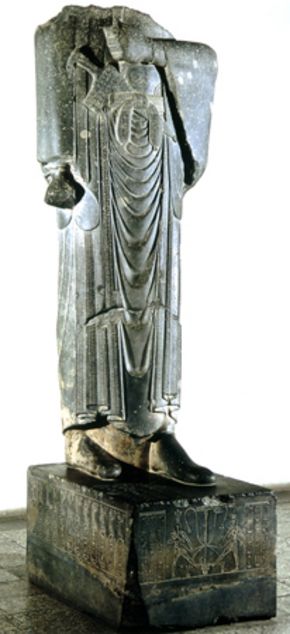
The statue of Darius I (Perrot J. ed., The palace of Darius at Susa, London 2013: fig. 262)
Susa, Iran
Tehran, National Museum of Iran
Grey metamorphic rock; H 246; base: H 51, W 64.2, L 104.3
Achaemenid period - Kingdom of Darius I (522-486 BC)
This monumental statue has been found at Susa in 1973. The monolithic statue, lacking of the head and damaged at the right hand, is in good state of preservation, with the stone surface carefully polished. The complete statue, with its base, must have measured some three metres in height.
The statue was fashioned in Egypt, commissioned by the king itself, as documented in the cuneiform inscriptions (in the three usual languages of the Achaemenid empire: Old Persian, Elamite and Babylonian) carved on the right side of pleated dress, while the left one carries the Egyptian hieroglyphic text.
The statue represents the king Darius I, standing on a massive base, with the left leg forward. The king wears the traditional ceremonial Persian pleated dress, with long sleeves, the same of the reliefs of Persepolis. A large belt, knotted at the front, ends in two metal plaques with the name of the king, written in Egyptian hieroglyphics. A precious dagger with crescent-shaped pommel is held on the belt, whose scabbard is decorated with friezes of winged bulls. The left arm, wearing a bracelet, is folded on the chest, and the hand is holding a broken stalk, probably of a lotus flower; the right arm hang down along the body.
The base bears Egyptian inscriptions; on its long sides there are the names of the twenty-four nations subjected to the Achaemenid empire, each one represented with a kneeling figure with his national costume and hair-dress, among which the Maka (i.e. Omani people). (AL)
